For the past two years I’ve been living with a heightened thrum of emotional complexity.
The greatest survival advice I’ve received came from my occasional psychologist, who reassured me, in a moment of particular stress, that I will not break. Whether or not this is true, it was, and has continued to be, a great comfort. Believing I will not break allows me to bend more deeply than I ever thought possible.
Some days I feel uniquely unskilled at this dual role I am playing as supporter-of-partner-with-cancer and supporter of son-with-autism. What they never tell you, in emotional elementary school, is that it’s all very well and good to imagine yourself a Platonic provider of aid, support, and comfort, but you also need to be mindful of, and prepared for, the effects the swirling complexity have on you, yourself. I’m still here. In other words.
A few months ago I managed to leave the kettle boiling: a carelessly placed plate wedged itself on top of the automatic shut-off switch, and so the kettle just kept boiling and boiling and boiling until I returned, 15 minutes later, to find the kettle hot, angry and depleted.
Sometimes it’s like that. And sometimes it’s not.
All of this has made me more sensitive, in both helpful and unhelpful ways; being attuned and empathetic is great until you find yourself, however temporarily, unable to find your way home. And being more sensitive has led me to recognize renderings of emotional complexity with new eyes and ears.
Two years after first hearing it, for example, I am unable to listen to Ingrid Michaelson’s Open Hands without crying.
Look, there, it happened again.
In this regard I am greatly in debt to British writer and actor Phoebe Waller-Bridge for the gifts she’s given us in recent years. Chief among these gifts is the BBC television program she wrote and stars in, Fleabag.
In the fourth episode of the first series, Waller-Bridge’s character, Fleabag, goes with her sister (played by the estimable Sian Clifford) to a silent retreat in the British countryside. She escapes from the retreat and encounters, by chance, her bank manager, played by Hugh Dennis, sitting at the edge of the property.
What follows is four minutes of the best television I’ve ever seen.
Hugh Dennis’s soliloquy is a masterful display of pathos, and one that hits close to home, specific circumstances aside.
Waller-Bridge, sitting beside him, says only seven words in the entire scene, and yet conveys so much otherwise that it is breathtaking.
This scene too I cannot watch without crying.
You can find Fleabag on the BBC, and on Amazon Video, among other places (the music, by the way, is Allistrum’s March from the self-titled album of Irish supergroup The Gloaming; you should seek it out too).
“I want to take clean cups, out of the dishwasher, and put them in the cupboard. at home. And the next morning I want to watch my wife drink from them. And I want to make her feel good.”
I have no greater wish.
Four years ago my friend Ken Williams and I cooked up a plan, which we dubbed TeacherNet, to provide teachers at Prince Street Elementary School with high quality wireless Internet. As I detailed here at the time, the genesis of the project went something like this:
Following from the January meeting of the Minister’s Advisory Committee on CIT and the later meeting with Premier Ghiz, Peter Rukavina prepared a report on the state of the education technology landscape for the board of the PEI Home and School Federation.
During the consideration of this report, we became aware of pilot projects, under the aegis of the French School Board, to install low-cost wireless routers connected to the community office Internet feed, to support both community users and educators in French schools.
Inspired by the French School Board project, with the Premier’s words in mind, and after discussion with educators and Terry MacIsaac, principal at Prince Street School, the notion of a similar wireless “pilot project” to test the viability of a low-cost parallel Internet network at the school was raised by the Prince Street Home and School. The principal encouraged the Home and School to pursue the project, and educators in the school were enthusiastic in their embracing possible uses of such a network in the school, so the decision was made to proceed.
With the support of the Prince Street Home and School, and with the cooperation and generosity of Bell Aliant, which provided the backhaul to the Internet, using low-cost wireless mesh routers Ken and I set up a network that covered the school. Every teacher and staff person had a username and password, and the Internet was completely unfiltered. After setting it all it, we stepped back and let things be, leaving the school to use its newfound superpower as it saw fit.
One of the things we had to agree to in our pilot project was that the provincial “help desk” wouldn’t be called upon to do support for the wireless infrastructure: Ken and I had to agree to handle this. Ken bore the brunt of this, but, fortunately, the network proved remarkable robust: most of the time it just worked.
It was reported in the minutes of the September Prince Street Home and School meeting that TeacherNet has served its purpose and will be shut down, replaced by government-installed-and-supported wireless Internet:
The school now officially has wifi provided by the Department of Education. The former TeacherNet, which was provided to the school as a project of Home and School, is being taken down —its work is complete. All the teaching staff has a laptop and there are computers in other locations around the school. There are also two full carts of Chromebooks plus 17 others to deploy as needed. Staff has been trained on the Chromebooks now. They are all web-based and memory is in the cloud. Work begun at school can be accessed at home and worked on from the home. Each student will have their own cloud account and sign-in. When people learn how to use it, it will be quite powerful.
None of this would have happened without the imagination and tenacity of Ken Williams, so please tip your hat to him next time you see him; he is a credit to technologists everywhere.
And it also wouldn’t have happened without being embraced by Bell Aliant, the Department of Education and the Eastern School District; we tend to think of bureaucracy, especially the technological bureaucracy, as being stubborn and implacable; one thing TeacherNet demonstrated is that if you make a solid technical and education argument, find the funds yourself, and are willing to roll up your sleeves and go into the school on a Saturday morning and string some cable, you can actually get things done.
TeacherNet may be dead, but the spirit of TeacherNet lives on.
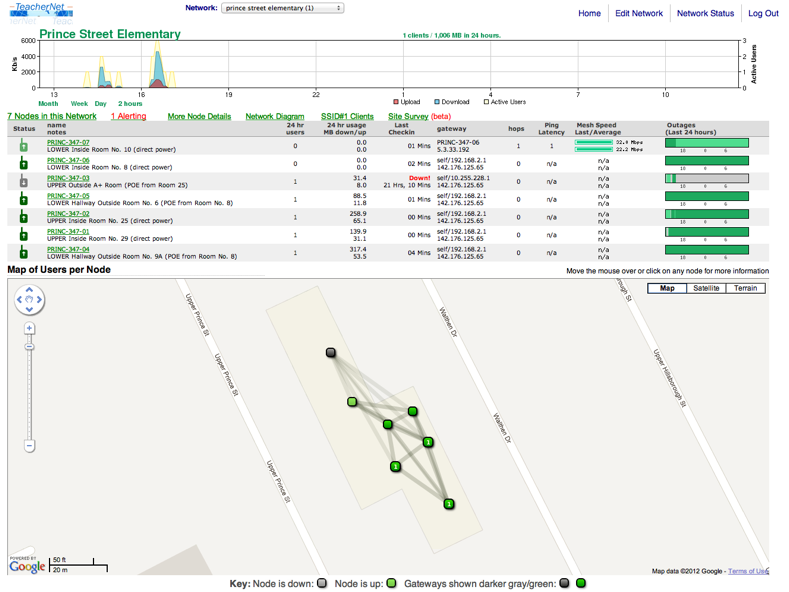
Compelling real political protest in front of Province House meets a fake Father of Confederation and his confused-looking tourist group on a Sunday morning.
I’m traveling in New England this week, and having reconciled myself to the fact that most travel SIM cards I’ve purchased in past result in no mobile service, I’ve just left my Canadian Virgin Mobile SIM in my phone, and I’m going without cellular data and limiting myself to texting (75 cents each) and not using the phone as a phone (at $1.45 a minute).
Yesterday I got a notification on my phone that I had voicemail waiting. I didn’t want to spent a couple of dollars to pick up a voicemail, so I called my own phone number from Skype, expecting that I’d be able to press “#” and enter a PIN to pick up my messages.
Except that I wasn’t prompted for a PIN at all: I was immediately dropped into the voicemail menu, and I was able to pick up my voicemail without authenticating at all.
At first I couldn’t figure out what had happened: did this mean that anyone could access my voicemail?
Then I realized that I’d set my Skype “Caller ID” number to the same number as my mobile number:
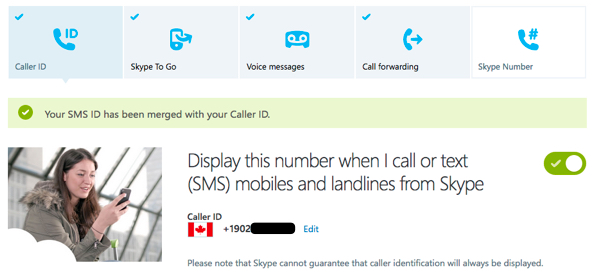
So Virgin Mobile was simply looking at the Caller ID, thinking that I was calling myself, and dropping me into my voicemail without prompting for a PIN.
That’s a problem.
There’s a verification hoop that you need to jump through when you set up a Skype Caller ID number (Skype sends you an SMS with a code you need to enter, which verifies you own the number). But that’s not always the case with other voice-over-IP systems that aren’t Skype: in many cases you can set your Caller ID to an arbitrary telephone number.
All of which means that if I know your mobile number, and I set my Caller ID in a VOIP system to that number, and you don’t have a voicemail PIN, it’s possible, in theory, for me to access your voicemail.
So I recommend that you do what I’ve just done, which is to set up a PIN for my Virgin Mobile voicemail, and to ensure that the “skip PIN” option is turned off.
I shipped Sonnet № 99 off to Oxford last Tuesday by UPS, with a promise that it would arrive there today.
It did not.
Here’s the latest UPS tracking information for the parcel:
![]()
The UPS call centre tells me that my parcel was “subject to a security scan which was beyond our control” by way of explaining the delay. It all goes well this won’t prevent the package from being at Oxford by the September 30 deadline – thank goodness I shipped it as early as I did – but I’ve little faith in UPS as I see the back and forth the parcel went through.
Charlottetown to Dieppe to Lachine to start things off make sense to me. But why did the parcel go across the border to Plattsburgh, 100 km away, only to come back to Lachine two days later, and then on to Mirabel, and then back to the USA to Louisville (UPS’s main hub) and then back up to Philadelphia (from where, I presume, it’s headed overseas).
Perhaps I’m too stuck on an old world “the fastest route from point A to point B” way of thinking about global logistics, but this makes no sense to me, and I can’t imagine why it’s efficient to send a parcel back and forth across the U.S. border twice when sending it from PEI to the United Kingdom.
Robert Morrissey was Minister of Economic Development in the Catherine Callbeck government in the early 1990s when I began work on the first website of the provincial government. As such, he was the first person I came to know as “the Minister,” and it takes every fibre of my being to call him Robert, let alone calling him “Bobby,” which is what he prefers, and what everybody else calls him.
In last year’s federal election, Robert (er, Bobby) was elected Member of Parliament for Egmont, the district on the western end of Prince Edward Island, and it was in this capacity that, through an intermediary, he reached out to me earlier this year to ask if I could help to facilitate a town hall on rural Internet access he was planning to host for his constituents. He needed someone impartial – which is to say, someone not in the Internet business themselves – to explain the basics of Internet access to those attending, and to sketch out what’s available on the ground right now, how much it costs, and, in the end, why it’s more expensive and slower than what we in urban PEI have access to.
I’m no Internet-access expert, but I know my way around the terminology, I’ve suffered from poor rural Internet myself (when I first crafted www.gov.pe.ca, it was on the end of a 14.4 Kbps modem connection), and I have some facility in explaining complicated things, so I agreed, and after some schedule juggling, this past Friday, September 23 was set as the date, and the St. Louis Community Centre, deep in the heart of West Prince, was set as the location.
St. Louis, in PEI terms, is a long drive from Charlottetown (the first time I had a meeting planning for the area, back in 1993, my coworkers were surprised to hear I wasn’t staying overnight). But it’s really not that far – 2 hours from door to door – and so I set off around 4:00 p.m. on Friday afternoon for a planned 6:00 p.m. arrival and setup and a 7:00 p.m. meeting.
The going was slow at first: torrential rain caused traffic in Charlottetown to grind to molasses, and by 4:45 p.m. I was still inside the Charlottetown city limits. But things picked up from there, and the farther I drove west the sunnier it became; by the time I got to St. Louis it was brilliant out:

I’d prepared a Keynote presentation earlier in the day, assembling all the research I’d gathered from talking to Internet service providers and scouring their websites, and Bobby’s staff had a screen projector set up at the front of the hall when I arrived, so it was quick to set up:
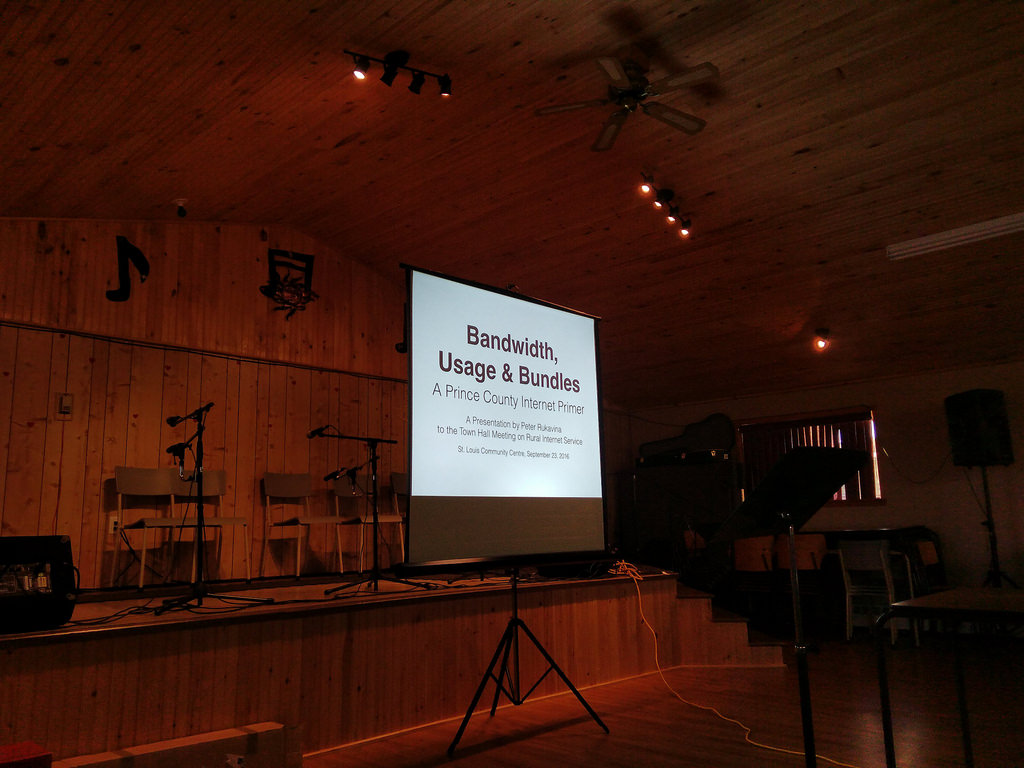
The plan was that Bobby would introduce me, and then I would speak for 15 or 20 minutes, and then he would take over and lead a discussion. By 7:00 p.m. there were about a dozen people in the hall (a hall, by the way, that is the envy of any community hall on PEI and has perhaps the most comfortable chairs of any hall I’ve ever been in). Bobby made a short introduction, and then I started in with my presentation.
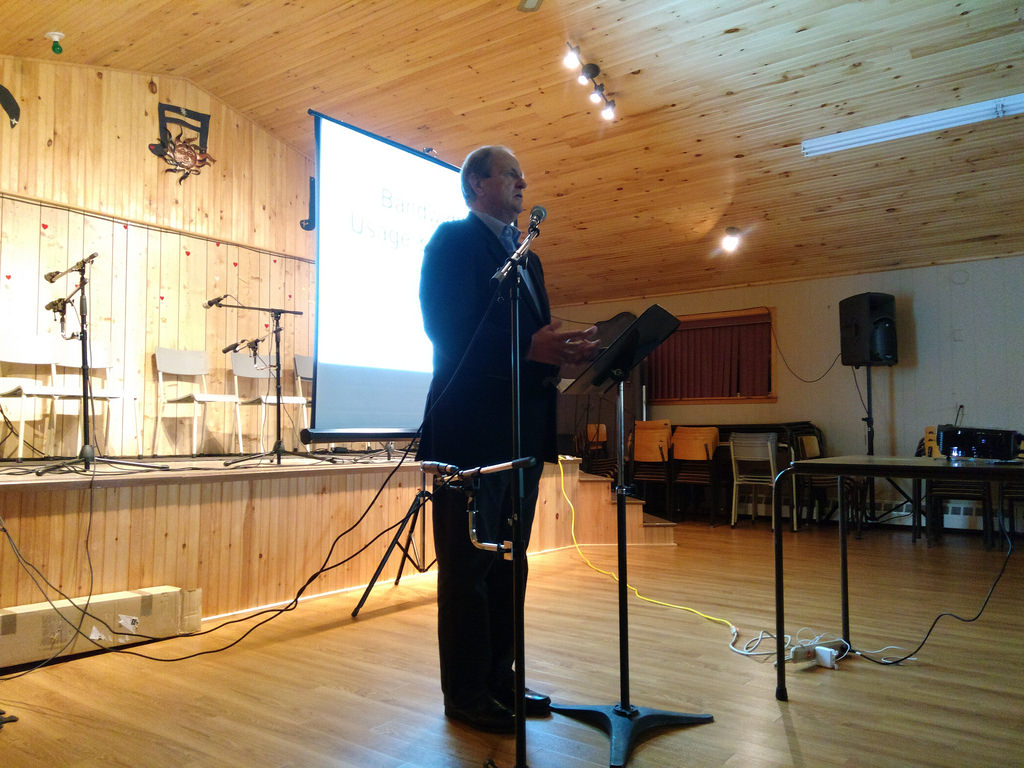
The goal of my presentation was to define the terminology people will encounter on Internet provider websites and phone calls (“bandwidth,” “usage,” “megs”), to talk about the ways of delivering Internet (fibre, DSL, cable, wireless) and then to review what companies are providing Internet in the riding, what they charge, and what they offer. I used the St. Louis Community Centre itself as a test address, and showed how the fastest Internet available at that address was 10 Mbps down and 1 Mbps up from Xplornet, and how that was 1/10th of what I could get in my office in Charlottetown while paying not that much more.
My plan to speak for 20 minutes and then to cede the podium to Bobby went off the rails when those present asked a lot of very, very good questions that I tried to answer completely. We talked about things like whether fibre to the home would ever extend to rural areas (unlikely), and about what the various wireless options are, and how they might be the quickest way to more bandwidth. We talked about the ins and outs of the Province attempting to lever its way to rural Internet in 2008, and how this worked and didn’t work both. Perhaps the wisest comment came from a constituent who reasoned that if I was paying $1 per Mbps of bandwidth in Charlottetown, he should be paying $2 a month for the 2 meg DSL service he’s getting at his house. I found it hard to argue with his logic.
The constituents who attended were wise, full of valuable insights, and made a clear case to Bobby about how lack of affordable, reliable bandwidth was holding back both economic development and education in the district. Bobby, to his credit, agreed this was the case – he has to drive in to Summerside to get the kind of Internet he needs to do business as an MP – and he genuinely seemed willing to listen to the solutions proposed, and to advocate for them.
I finally sat down about 8:30 p.m., and Bobby took the floor to summarize things and to close the discussion. We didn’t leave the hall with a plan, but I hope that everyone left a little wiser, and with a sense that the only things standing between West Prince and bandwidth are money and the will.
I headed out into the clear, dark night at 9:00 p.m., stopped at my friend John Cousins’s house in Bloomfield for a cup of tea and a chat before heading back to town. I rolled into my driveway back in Charlottetown near 1:00 p.m., 9 hours after leaving, satisfied and exhausted.
I was, as a child, always intrigued by the end credits of the TV shows we watched that mentioned the providers of the stars’ outfits. For The Dick Van Dyke show, for example, it was always Mr. Van Dyke’s Wardrobe Furnished By Botany 500.
What was “Botany 500,” I wondered. And what did it mean that they “furnished” his wardrobe: were the clothes free, in return for the promotion in the credits? Did everything he wore come from Botany 500? Without Wikipedia, my childhood self was left to wonder.
But my adult me has ready access to the information:
Botany 500 has provided wardrobe for many game show hosts and television presenters, including Phil Donahue of The Phil Donahue Show.
In addition, the company provided the wardrobes for Danny Thomas on Make Room for Daddy, John Newland on Alcoa Presents: One Step Beyond, Dick Van Dyke on The Dick Van Dyke Show, Don Adams on Get Smart, Mike Connors on Mannix, Telly Savalas on Kojak, Bob Newhart on The Bob Newhart Show, Dick Sargent on Bewitched, Brian Keith and Sebastian Cabot on Family Affair, Sherman Hemsley on The Jeffersons, Lyle Waggoner on Wonder Woman, Peter Graves on Mission: Impossible, Jack Klugman on Quincy, M.E., and Bill Macy and Conrad Bain on Maude.
Those are the men and their shows of my television youth, which explains why Botany 500, to this day, is imprinted on my branding brain.
My mind turns to such things because this week, for the first time in my life, I appeared was on TV in a more-than-just-CBC-dropping-by-unexpected kind of way, and I had to give thought to what I would wear.
Fortunately recent events conspired to prepare me.
Earlier this year when Prince Edward visited Government House to present the Duke of Edinburgh Awards, I was invited to represent Home & School. But dress was formal, said the invite, and all I had in my closet was the ill-fitting suit I kept around for wakes and funerals (purchased at Henderson & Cudmore when I was 30 pounds heavier).
On short notice, Dow’s Men Wear came to my aid, outfitting me with a sharp Calvin Klein good-for-almost-anything jacket that served me in good stead.
This summer when I was in Sweden for [[Olle]] and [[Luisa]]’s 10th wedding anniversary party, better dress was also called for, and so, with friend [[Jonas]]’s help, I located a tie dealer on the high street and purchased a beautiful striped purple tie and has similarly served me well.
For trousers I turned to my standby, a pair I purchased from Dow’s a few years ago; at the time spending that much for pants seemed crazy, but they were worth it, and they’re good for everything from walks on the beach to dinner with the Queen.
All of which is to say that if this week hand end credits, they would read:
Mr. Rukavina’s Hair by Zack Squires
Wardrobe furnished by Dow’s
Shirt by Target
Tie by John Henric
Sneakers by Rieker
Botany 500 it ain’t, but it did the job. And they never point the TV cameras at your feet.
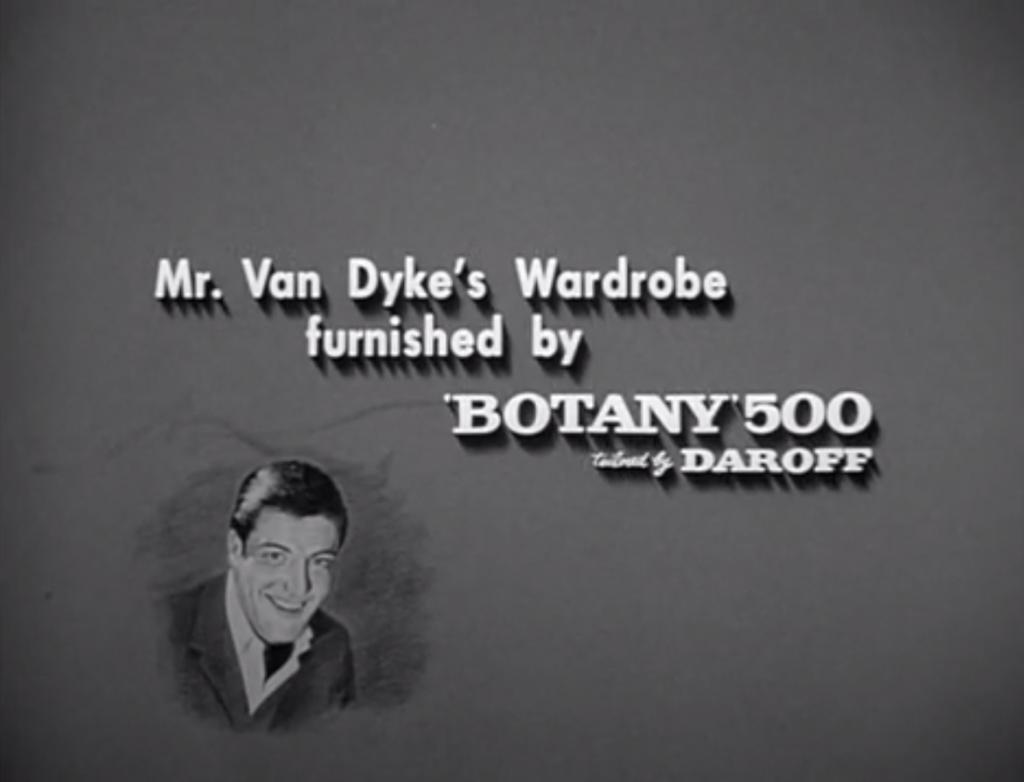
The day I happened to be in Halifax this week happened to be the day that all Prince Edward Island schools were evacuated, so [[Catherine]], bless her soul, bore the brunt of consequences-management.
While a school evacuation is stressful for everyone, it was a perfect storm of anxiety and stress for Oliver: he explained it to me last night on the phone as being stressful and then stressful stressful because he was sponging up everyone else’s stress too. He had the love and support of his teachers and EAs (and then Catherine, once she arrived on the scene) to help him through the worst of it, but it was a hard, hard day.
What gives me great comfort as his father, though, is that in the aftermath of all this he found ways of writing about what he was feeling. Like this:
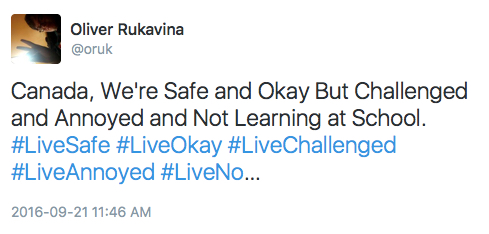
and like this:
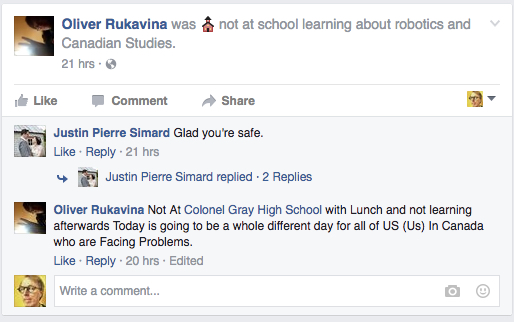
and like this:
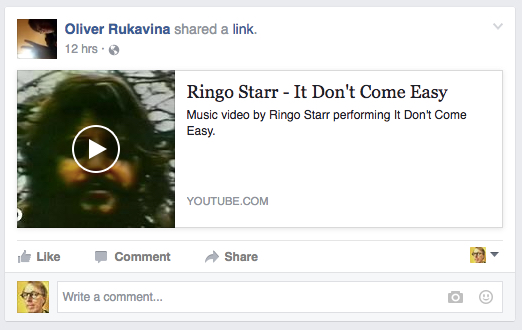
I can be as cynical as the next person about the corrosive effects of Facebook and Twitter on our lives, but these social media have given Oliver a platform to express his feelings – often with eloquence that belies his age – in community. And for that I am grateful, and for that I am proud.
Oliver told me the other day that people need to remember that autism isn’t an illness, it’s a way that you are. One of the many gifts I receive from fatherhood is watching him figure out what that means.
When I last wrote, earlier today, I was between a television appearance and a radio appearance, parts of my visit to Halifax to talk about the 2017 Old Farmer’s Almanac.
The day has continued to be Almanac-filled: after those interviews, I spoke to a reporter at Cochrane Now on the phone about the upcoming Alberta winter, and then, just now, did a live hit on Regina’s CJME News MainStreet program about Saskatchewan’s.
Here are the results of my day’s work.
Global News Halifax
I started the day on television; you can read more about it here. This is the resulting piece from the Global website:
News 95.7 – The Rick Howe Show
After starting the day on television, I had some time to cool my jets in the Halifax Central Library before heading across town to News 95.7 to appear on The Rick Howe Show.
Rick was great: curious, professional, funny; the kind of radio interviewer that every guest hopes for.
Here’s the audio of our chat from the station’s website:.
CJME MainStreet
This was a last-minute addition to my schedule, a late-afternoon phone call into this Regina afternoon talk show hosted by Jill Slater and Dave Arnold. Ironically, the segment opens with discussion of the Island-wide school evacuation back home that affected [[Oliver]] and his peers; but I was in Halifax, and there was winter weather to talk about, so it didn’t come up. I appreciated Dave and Jill’s enthusiasm for the Almanac, and for talking weather.
Here’s the station’s podcast of the segment:
It’s fun to talk about The Old Farmer’s Almanac, and I’m proud to be a small part of this years effort to announce the new edition to the world.
The fun continues tomorrow morning when I’ll appear on CTV Morning Live Atlantic after 7:00 a.m. Then it’s home to the Island to enjoy the weather itself after two days of talking about its predicting.
Back in June, when visiting with my colleagues at The Old Farmer’s Almanac, I naively said something like “if you ever need anyone in Canada to help with promotion of the 225th edition in the fall, just let me know.”
As it happens, they took me at my word, and so a few weeks ago I got my “media tour” schedule. As a result, here on this last day of summer, I am in Halifax, dressed in a shirt and tie, talking about the Almanac for the day.
My first appointment was with Andrea Dion, host of Global TV’s Halifax morning news. My call-time was 7:30 a.m. for a 7:50 a.m. interview, so I showed up, of course, at 7:00 a.m. Fortunately there’s a comfortable coffee place next door, so I was able to grab a coffee and review my solar science for half an hour.
At 7:30 a.m. I went next door, was shown into a comfortable lobby by an amiable security guard; a few minutes later Andrea came down to meet me, and walked me up into the spacious studio:

Remember that episode of WKRP in Cincinnati, “Venus Rising,” where Venus gets hired by WREQ, a automated radio station? Global TV in Halifax is eerily like that: other than Andrea, and the news reader, and the security guard, there didn’t seem to be anyone else present (although Andrea was speaking to someone in her earpiece, so there must have been someone, somewhere, controlling things). The cameras had no camera operators. There were no makeup people, or producers, or directors. In other words, picture in your mind an episode of HBO’s The Newsroom (or, for that matter, the CBC’s) and then remove all the secondary characters. Like that.
Fortunately Andrea was multi-talented, playing many roles at once: she got me set up with a wireless microphone (actually, with two microphones, as a fail safe), set a copy of the Almanac on a book stand, and did a short pre-interview with me.
At 7:50 a.m. we were live to Atlantic Canada and talking about long range weather.
It’s important to recall at this point – as I hastened to mentioned in the interview – that I work in the engine room of the The Old Farmer’s Almanac, and so the sorts of questions I’m used to answering are more “why isn’t the map rendering properly in Firefox on Samsung mobile devices in Kentucky?” and less “can you explain La Niña’s effects on this winter’s weather?” Of course I’ve studied, and have the benefit of 20 years of osmotic uptake of Almanac methodology in my pocket. But I also have an almost pathological inability to read and recall complicated things like “it’s going to be a colder, snowier winter in Atlantic Canada, with the cold coming in mid- to late-December, mid- to late-January and mid-February and the heaviest snow in mid- to late-December, through most of January and in mid- to late-February” (what you can’t see is me referring to my notes to be able to type that).
Fortunately, I think, I managed to do justice to the winter weather forecast, and did not end up committing any untruths to television. I was greatly aided in this regard by Andrea, my inquisitor, who is a skilled, knowledgeable interviewer.
After 5 minutes it was all over, the microphone returned to its bay, and farewells bade.
I’ve got a 2 hour break now before moving on to News 95.7 to appear on The Rick Howe Show at the noon hour where I am billed thusly:
An editor of the Old Farmer’s Almanac, Peter Rukavina joins us in studio to tell us about the new almanac and its winter forecast.
My appearance falls between “Physician Dr. John Gillis answers callers’ questions about health” and “Premier Stephen McNeil weighs in on the provincial worries about a nationally-imposed carbon tax.”
Wish me luck.

 I am
I am